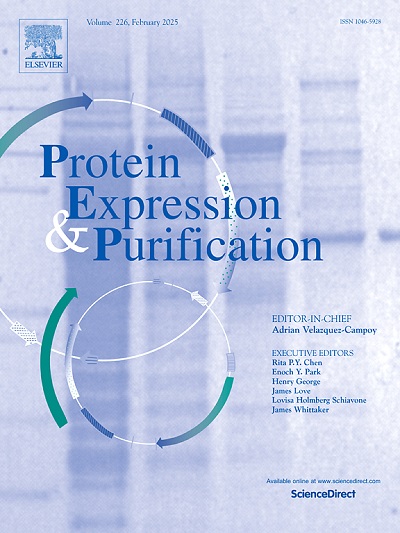A FRET-based competitive binding assay using coumestrol and the ligand-binding domain of human estrogen receptor alpha tagged with mTurquoise2 efficiently expressed in E. coli with ethanol
IF 1.2
4区 生物学
Q4 BIOCHEMICAL RESEARCH METHODS
引用次数: 0
Abstract
The estrogen receptor (ER) is a nuclear receptor and one of the most extensively researched targets in the study of endocrine-disrupting chemicals (EDCs). Many biosensors and bioassays for estrogenic EDCs use the ligand-binding domain of human ERα (LBD-hERα) as a biological recognition element. However, the LBD-hERα is poorly stable and difficult to produce as a functional LBD-hERα in the E. coli expression system. In this study, we efficiently expressed the functional LBD-hERα tagged with the cyan fluorescent protein, mTurquoise2 (LBD-hERα-mTq2) by the addition of ethanol (3 %) to E. coli suspension during protein expression (> 40 times more compared to without ethanol). We found that ethanol not only promoted the proper folding of LBD-hERα-mTq2, but also prevented the proteolysis of poorly folded recombinant proteins. We established a FRET-based binding assay between a fluorescent estrogen, coumestrol, and the LBD-hERα-mTq2, in which the formation of the complex exhibits a significant degree of FRET. A subsequent competitive binding assay with diethylstilbestrol demonstrates that our system successfully functions as a simple and reliable bioassay to detect estrogenic EDCs.
一种基于fret的竞争结合实验,使用库美醇和人雌激素受体α的配体结合结构域,标记mTurquoise2,在大肠杆菌中与乙醇有效表达。
雌激素受体(ER)是一种核受体,是内分泌干扰物(EDCs)研究中研究最广泛的靶点之一。许多雌激素EDCs的生物传感器和生物测定都使用人ERα的配体结合结构域(LBD-hERα)作为生物识别元件。然而,在大肠杆菌表达系统中,LBD-hERα稳定性差,难以作为功能性的LBD-hERα产生。在本研究中,我们通过在大肠杆菌悬液中添加乙醇(3%),在蛋白表达过程中高效地表达了带有青色荧光蛋白mTurquoise2 (LBD-hERα- mtq2)的功能性LBD-hERα(比不添加乙醇高40倍)。我们发现乙醇不仅促进了LBD-hERα-mTq2的正确折叠,而且还阻止了折叠不良的重组蛋白的蛋白水解。我们建立了基于FRET的荧光雌激素、库美孕酮与LBD-hERα-mTq2结合实验,其中复合物的形成表现出显著程度的FRET。随后与己烯雌酚的竞争性结合试验表明,我们的系统成功地作为一种简单可靠的生物测定方法来检测雌激素性EDCs。
本文章由计算机程序翻译,如有差异,请以英文原文为准。
求助全文
约1分钟内获得全文
求助全文
来源期刊

Protein expression and purification
生物-生化研究方法
CiteScore
3.70
自引率
6.20%
发文量
120
审稿时长
32 days
期刊介绍:
Protein Expression and Purification is an international journal providing a forum for the dissemination of new information on protein expression, extraction, purification, characterization, and/or applications using conventional biochemical and/or modern molecular biological approaches and methods, which are of broad interest to the field. The journal does not typically publish repetitive examples of protein expression and purification involving standard, well-established, methods. However, exceptions might include studies on important and/or difficult to express and/or purify proteins and/or studies that include extensive protein characterization, which provide new, previously unpublished information.
 求助内容:
求助内容: 应助结果提醒方式:
应助结果提醒方式:


